Drive-By Gardens: Formal, whimsical, and wildflower gardens in central Austin
Central Austin’s front-yard gardens, free of any homeowners’ association rules, vary wildly depending on the owners’ tastes, energy level, and budget. Here are three that caught my eye over the past week, starting with Deborah Hornickel’s subversive formal garden in the Bryker Woods neighborhood. Why subversive? It starts out all classical, very orderly with formal lines, matching pots on plinths, and clipped boxwood. (And how about that stunning, tree-pruned loropetalum at left?)
And then it breaks free of tradition on either side of the topiary-edged front walk with overscaled, dramatic plants mixed with sprinklings of seedy wildflowers. It’s a surprising dynamic.
Anyone know this pretty-in-pink flower next to the potted dyckia?
If you’d like to see more, I’ve posted about Deborah’s garden twice before, when it was on the Open Days tour in fall 2010 and Open Days fall 2006. Her back garden is formal-meets-contemporary.
In the tony Tarrytown neighborhood, I spotted this modern home with a surprisingly whimsical garden. Check out that undulating wooden fence. Somehow it reminds me of Hobbiton. There’s also a concrete spiral near the driveway. I’m not sure what the purpose is — maybe just for fun? And wow, look at that acacia in golden bloom.
Near the driveway, in a circular, mortared-stone planter that looks a bit homemade — not at all modern — sits a gorgeous variegated American agave. How I wish I had room for one of these.
My variegated agave lust was also tempted here, at a traditional Enfield home with a surprisingly wild gravel garden of California poppy, agave, bulbine, Mexican feathergrass, and blackfoot daisy.
Ka-pow! No way could I drive by that without stopping. What a beautiful, low-water garden for a hot, sun-blasted corner.
All material © 2006-2015 by Pam Penick for Digging. Unauthorized reproduction prohibited.


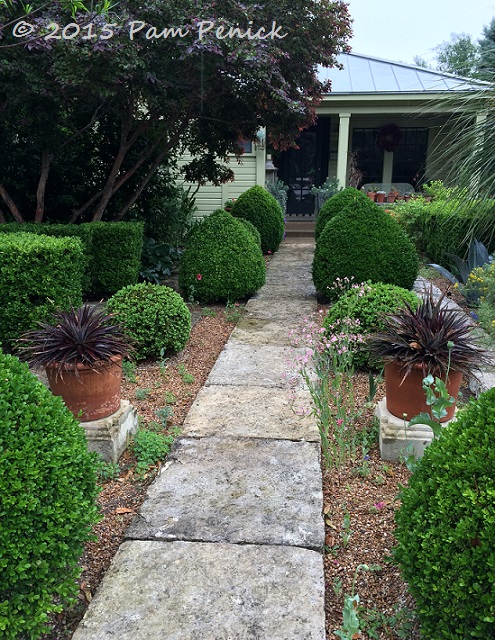
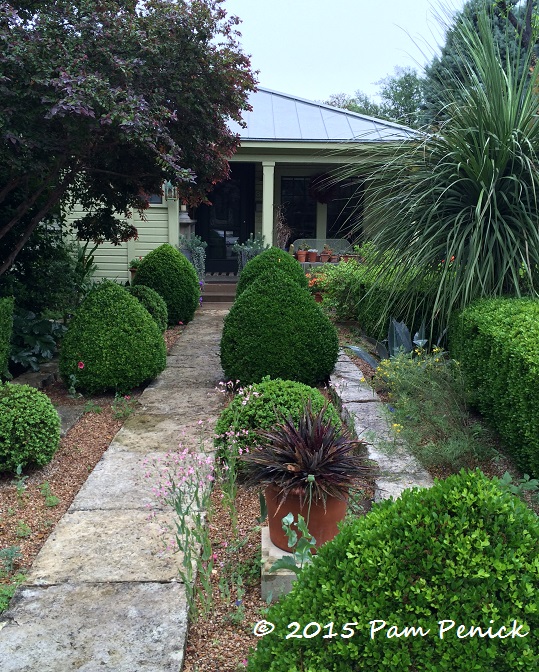
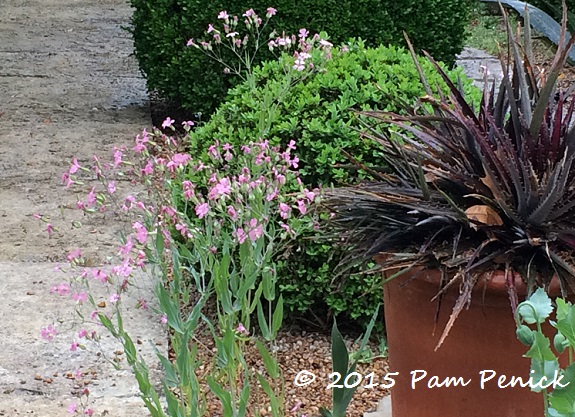
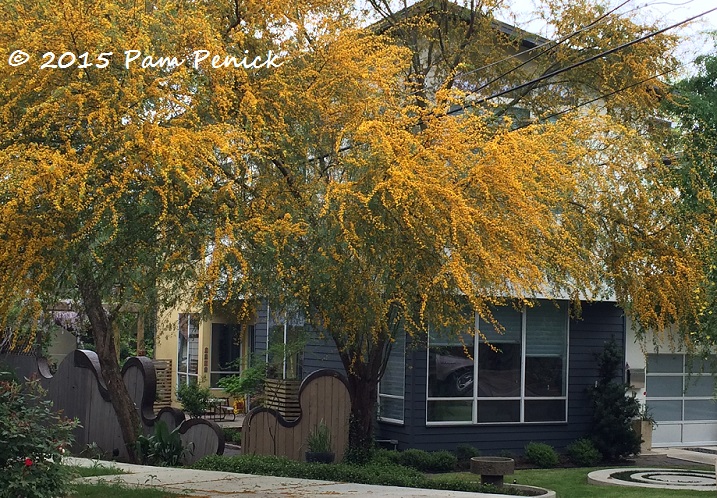
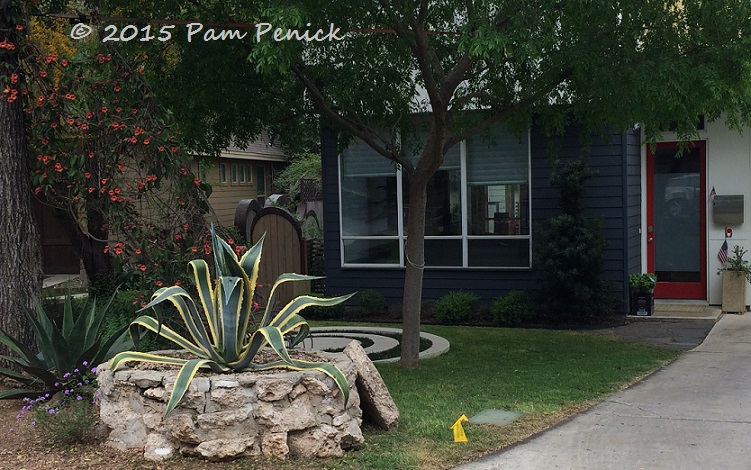
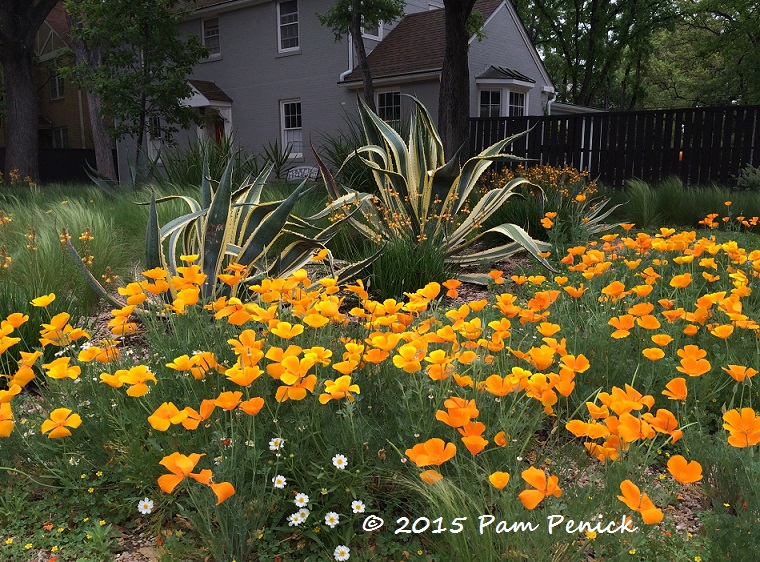
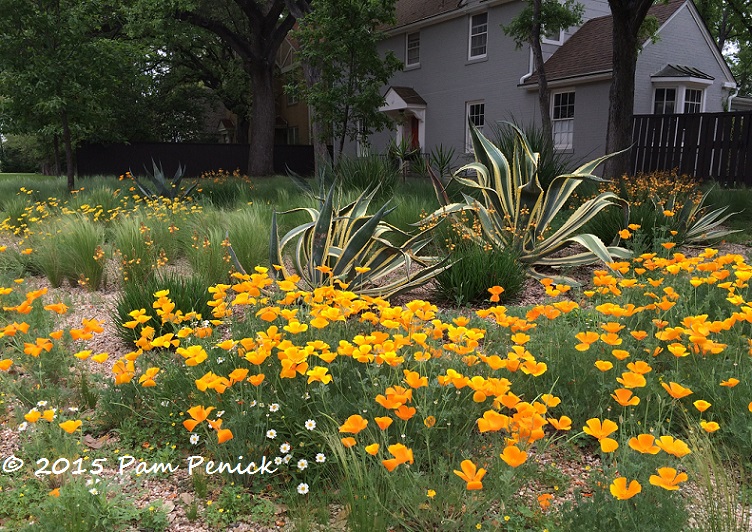
What fun gardens. I understand the Agave lust. I’ve lost 3 variegated Americana agaves to the cold. This year I lost a fairly large one that seemed pretty protected.
I used to grow it in my old garden, Diana, and now and then I’d lose one to a hard freeze. I’m surprised you lost one this year, though, as we didn’t have prolonged sub-freezing temps. Bummer! —Pam
Great gardens.
That’s a Loropetelum? Wow!
It’s stunning, isn’t it? —Pam
The stems on the pretty-in-pink flower look like dayflower. Dayflower is typically blue, but lilac and lavender also occur.
http://en.wikipedia.org/wiki/Commelina
Thanks for taking a guess at an ID, Rose. I agree its form resembles dayflower, but it seems more erect, less floppy. Maybe that’s just a factor of growing in full sun, in well-drained gravel? And that color — so unlike any dayflowers I’ve ever encountered. —Pam
Dianthus?
What fun to see Deborah Hornickel’s garden again, Pam!
I’ll bet that pink flower is Tinantia erecta – Nan Ondra grows it http://hayefield.com/tag/tinantia-erecta/.
It might be related to our Central Texas annual native False Dayflower, Tinantia anomola. This plant self-seeds in my garden but is a light lilac color.
I knew I could count on you to take a stab at an ID, Annie. Although climate differences can make a plant look lusher elsewhere than it does here, I’m not sure if the Tinantia erecta is a match. Nan’s plant appears to have fleshier stems and leaves and fuller overall form than Deborah’s, don’t you think? Perhaps it is related to the dayflower, although it seems distinct from that too. I wish I’d gotten a better photo, but I only had my cell and I was shooting from the street. —Pam
Maybe Deborah Hornickel will see your photo and clue us in, Pam.
Whatever this dayflower-type plant is called, it looks just right springing from the gravel, doesn’t it?
Yes, it’s beautiful! —Pam
That gravel garden is stunning! I’d love to see it in the fall. IThank you for sharing such ininspiration.
I would like to know how it changes with the seasons too, Heather. Of course the poppies will be gone soon, but the feathergrass, bulbine, blackfoot daisy, and agaves will remain. Maybe something else pops up too. —Pam
These are FUN! I always lust after those big agaves.
I have a few other big agaves, but I love the snazzy stripes of this one. —Pam
Love front yard gardens and these are fun. The colors contrast in the gravel garden is wowzer!
Traffic-stopping, Gail. —Pam
These gardens must be disturbed by the sound of screeching brakes on a regular basis. The mystery plant looks like Lychnis to me. I have some with bright magenta flowers, Lychnis coronaria, but the silvery foliage and flower form look the same, and I know there is a pink form.
It does seem similar to rose campion. Thanks for the suggestion, Ricki. —Pam
The packrats ate my bulbine. Little beasts.
Rats! —Pam
Love the poppies in the gravel garden. Not sure what the pink flower is, but I would look in the Lychnis/Silene groups.
I’m leaning that way too, Christopher. —Pam
The colors in those gardens work so well against the house colors. These gardens all represent really thoughtful choices despite how casual some of them appear to passersby.
Perhaps the spiral is a mini-labyrinth? (I have no idea what that mystery plant is but didn’t want to be left out of ALL the guessing.. : ).
Perhaps it IS a labyrinth of sorts. It’s fun, anyway. —Pam
Pam, the flowers remind me of the flowers in the phlox family and they are good spring bloomers…. my guess is Aliciella formosa, Aztec gilia. Good luck.
Oh, that’s a pretty one. I’m not sure it’s a match, though — the leaves look a bit different. I wish Deborah, the owner, would happen to see this and end the suspense! —Pam
I really liked the fence and front yard…but the last pics of the agave and simple grasses with the spot of poppies = almost perfect!
And it would work just as well in El Paso, no? —Pam
My crack at the pretty in pink – viscaria oculata in it’s native form as in less hybridized. There are local seed sources, but this site had the best picture: http://www.gardenpost.co.nz/product/1811/.
Oh my, such a lot of possibilities. I confess I’m stumped. The viscaria is similar but not quite a match, I think. I’m going to have to find a way to ask Deborah. Thanks for sharing your guess, Walt! —Pam
I kept wanting it to be soapwort – the paired leaves, the spraying of the flowers – and I think I finally found what I was looking for: Cow Soapwort or Cow Cockle.
http://uswildflowers.com/detail.php?SName=Vaccaria%20hispanica
Michael, I believe you may have hit on the right answer. That really does look like the plant I saw. Thanks for the link. —Pam
It really does look like some type of soapwort, Pam. Please keep us posted when you find out for sure. Love any kind of flower on a stick.
It makes a pretty softening for a gravel garden, doesn’t it? —Pam